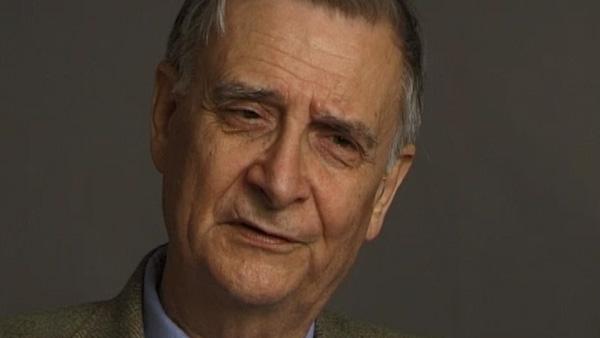NEXT STORY

Why I study ants
RELATED STORIES

NEXT STORY

Why I study ants
RELATED STORIES


|
Views | Duration | |
|---|---|---|---|
| 1. I never grew out of my bug period | 6 | 657 | 05:04 |
| 2. 'If you don't like mathematics, don't give up' | 2 | 839 | 02:59 |
| 3. A grand tour with Thomas Eisner | 1 | 296 | 05:23 |
| 4. Eating a big green katydid | 78 | 02:57 | |
| 5. Discovering ant colonies | 218 | 05:05 | |
| 6. Why I study ants | 362 | 01:09 | |
| 7. The Ants | 249 | 03:05 | |
| 8. Our book receives the Pulitzer Prize | 1 | 231 | 02:18 |
| 9. Fieldwork is exhilarating | 196 | 03:07 | |
| 10. The truly grand experience of my career | 207 | 06:09 |

My first scientific discovery was made when I was 13, but I didn't realise it was a scientific discovery until maybe five years later. And that was the discovery of the first imported red fire ants in the United States. These insects came from, we now know, along the Argentine/Brazilian border, and when introduced by shipping in the port of Mobile, Alabama, in the American South, then quickly spread through the South where today they range from North Carolina to Texas and are among the principle insect pest of the Southern United States.
I happened to be living in our family home which our family had occupied since the 1840s, a few blocks from the Mobile shipyards. As a 13 year old, collecting butterflies and this and that, I decided I was going to make a survey of all of the ants right around my house, including a vacant lot, turning old whiskey bottles over and rocks, and breaking up pieces of rotting wood and so on, something I do today. You know, I never really change my ways of doing field work. But one of the ants that I discovered in the course of this was a mound of imported fire ants. There was no question about it, I made thorough studies of it, and in fact it was only five years later that I was now fully aware, and I began to help local naturalists and others find and identify the imported red fire ant. And I was hired at 19, I was a senior in college then, by the State of Alabama, to make the first survey. So I knew that I had gotten the first record of that, in the United States.
One of the most aesthetically pleasing experiences of my field work was in 1953 when I made my first trip to the tropics, from Harvard University. I undertook studies of ants in Cuba, searching up and down for patches of forest that left remaining of the original Cuban cover. Extremely little is left, and what is left is mostly in the mountains. Some 40 years before that, one of my predecessors at Harvard, a man named William Mann, had gone down as a student himself and in the course of his studies in mountains in Central Cuba, east of Cienfuegos, had come upon a metallic green ant. You know, shiny metallic green ant. That is metalescent, not metal obviously. That was green, you know, it reflects green light. And he described how he had been up in the mountain forest and he'd pulled a rock over and it had split and there was a cavity in the middle of that rock filled with these metallic green ants. And he named them later as a new species, Macromischa wheeleri, after his professor William Morten Wheeler, who was my predecessor as curator of insects here at Harvard, that is by one generation, he was one... two generations before me of curators.
So when in Cuba, I was so enchanted by that story of the metallic green ants, teaspoonful as he put it, in the middle of a soft rock, that I went to the locality with a group of others, Mina Carlota in the mountains, and I started looking. And I looked, and I searched and I searched, and then I was halfway up a slope, and I pulled over a soft rock and it broke in two, and there was a cavity, and there was a teaspoonful of Macromischa wheeleri. Fascinating place, Cuba, for the ants. It's not what you usually think of when you think of Cuba. But there are a whole array of native ants which are variously metallic, metalescent blue, blue... metallic blue reflection. Green. And I found one, I hadn't... I wasn't the first to discover it, but I was one of the first to see it alive in the field, and therefore could see the original colours, that was metalescent gold. A gold ant. You could see them foraging in the sunlight, you know, in the shrubs. One of these days when Cuba, shall we say a little freer of access, I'd like to go back and repeat those experiences.
EO Wilson (1929-2021) was an American biologist, researcher (sociobiology, biodiversity), theorist (consilience, biophilia), naturalist (conservationist) and author (two Pulitzer Prizes). His biological specialty was myrmecology, the study of ants.
Title: Discovering ant colonies
Listeners: Christopher Sykes
Christopher Sykes is a London-based television producer and director who has made a number of documentary films for BBC TV, Channel 4 and PBS.
Tags: Harvard University, Cuba, Cienfuegos, Macromischa wheeleri, Mina Carlota, Cuba, Harvard University, William M Mann, William Morton Wheeler
Duration: 5 minutes, 6 seconds
Date story recorded: 2000
Date story went live: 22 May 2018